
The Lincoln Memorial is a U.S. national memorial that honors the 16th president of the United States, Abraham Lincoln. Built in the form of a neoclassical temple, it is at the western end of the National Mall in Washington, D.C. Henry Bacon is the memorial's architect. Daniel Chester French designed the large interior statue, Abraham Lincoln (1920), which was carved in marble by the Piccirilli brothers. Jules Guerin painted the interior murals, and the epitaph above the statue was written by Royal Cortissoz. Dedicated on May 30, 1922, it is one of several memorials built to honor an American president. It has been a major tourist attraction since its opening, and over the years, has occasionally been used as a symbolic center focused on race relations and civil rights.

The Greek Revival was an architectural movement which began in the middle of the 18th century but which particularly flourished in the late 18th and early 19th centuries, predominantly in northern Europe and the United States and Canada and in Greece itself following its independence in 1832. It revived many aspects of the forms and styles of ancient Greek architecture, in particular the Greek temple. A product of Hellenism, Greek Revival architecture is looked upon as the last phase in the development of Neoclassical architecture, which was drawn from Roman architecture. The term was first used by Charles Robert Cockerell in a lecture he gave as an architecture professor at the Royal Academy of Arts in London in 1842.
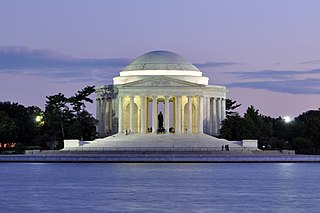
The Jefferson Memorial is a presidential memorial built in Washington, D.C., between 1939 and 1943 in honor of Thomas Jefferson, the principal author of the United States Declaration of Independence, a central intellectual force behind the American Revolution, founder of the Democratic-Republican Party, and the nation's third president.

The World War II Memorial is a national memorial in the United States dedicated to Americans who served in the armed forces and as civilians during World War II. It is located on the National Mall in Washington, D.C.
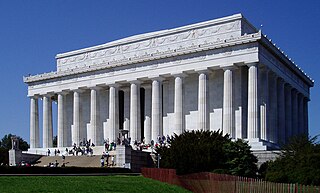
Henry Bacon was an American Beaux-Arts architect who oversaw the engineering and design of the Lincoln Memorial in Washington, D.C., built between 1915 and 1922, which was his final project before his 1924 death.

The American Battle Monuments Commission (ABMC) is an independent agency of the United States government that administers, operates, and maintains permanent U.S. military cemeteries, memorials and monuments primarily outside the United States.

The Oise-Aisne American Cemetery and Memorial is an American military cemetery in northern France. Plots A through D contains the graves of 6,013 American soldiers who died while fighting in this vicinity during World War I, 597 of which were not identified, as well as a monument for 241 Americans who were missing in action during battles in the same area and whose remains were never recovered. Included among the soldiers here who lost their lives is poet Joyce Kilmer.

Paul Philippe Cret was a French-born Philadelphian architect and industrial designer. For more than thirty years, he taught at a design studio in the Department of Architecture at the University of Pennsylvania.

The history of sculpture in the United States begins in the 1600s "with the modest efforts of craftsmen who adorned gravestones, Bible boxes, and various utilitarian objects with simple low-relief decorations." American sculpture in its many forms, genres and guises has continuously contributed to the cultural landscape of world art into the 21st century.

Perry's Victory and International Peace Memorial commemorates the Battle of Lake Erie that took place near Ohio's South Bass Island, in which Commodore Oliver Hazard Perry led a fleet to victory in one of the most decisive naval battles to occur in the War of 1812. Located on an isthmus on the island, the memorial also celebrates the lasting peace between Britain, Canada, and the United States that followed the war.

The Forest of Argonne is a long strip of mountainous and wild woodland in northeastern France, approximately 200 km (120 mi) east of Paris. The forest measures roughly 65 km (40 mi) long and 15 km (9 mi) wide filled with many small hills and deep valleys formed by water run-off from the Aire and Aisne rivers rarely exceeding more than 200 m (650 ft) in elevation. Following the First World War, the landscape of the forest was forever changed as trench warfare led to parts of the forest being riddled with deep man-made trenches along with craters from explosives. The forest is bordered by the Meuse (Aisne?) River on the west and rolling farmland and creeks to the east. The forest is largely oak, chestnut, and pine trees, and ferns cover much of the forest floor. Common animal life consists of wild boar, red deer, roe deer, hares, rabbits, foxes, and wildcat.
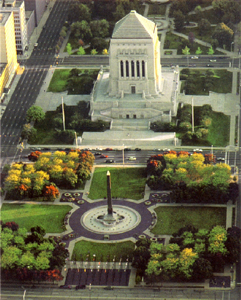
The Indiana World War Memorial Plaza is an urban feature and war memorial located in downtown Indianapolis, Indiana, United States, originally built to honor the veterans of World War I. It was conceived in 1919 as a location for the national headquarters of the American Legion and a memorial to the state's and nation's veterans.
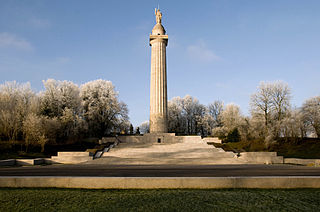
The Meuse-Argonne American Memorial is an American World War I memorial commemorating "the brilliant victory of the American First Army in the Meuse-Argonne offensive, September 26 – November 11, 1918, and pays tribute to the previous heroic services of the Armies of France on the important battle front upon which the memorial has been constructed." It was erected by the United States Government and is the largest of the American war memorials in Europe. Outside Montfaucon in the Meuse department in Grand Est in north-eastern France, it was unveiled on August 1, 1937. The memorial was designed by John Russell Pope. He designed a massive, Doric column in granite. It is surmounted by a statue symbolic of liberty and towers 71 metres (233 ft) above the hill and the war ruins of the village around it.

The St. Mihiel American Cemetery and Memorial is located at the west edge of Thiaucourt (Meurthe-et-Moselle), France. The 40.5 acres (16.4 ha) cemetery contains the graves of 4,153 American military dead from World War I. The majority of these died in the Battle of Saint-Mihiel, an offensive that resulted in the reduction of the St. Mihiel salient that threatened Paris. The American Battle Monuments Commission administers the cemetery.

The Château-Thierry American Monument is a World War I memorial, dedicated in 1937, located near Château-Thierry, Aisne, France. Architecturally it is a notable example of Stripped Classicism.
Alfred-Alphonse Bottiau was a French sculptor. He was born in Valenciennes and after early studies in his home town he studied in Paris under Jean Antoine Injalbert and was runner-up for the Prix de Rome for sculpture in 1919. Bottiau had joined the army in 1910 and served until 1919. He was director of the Écoles Académiques de Valenciennes from 1946 to 1951.
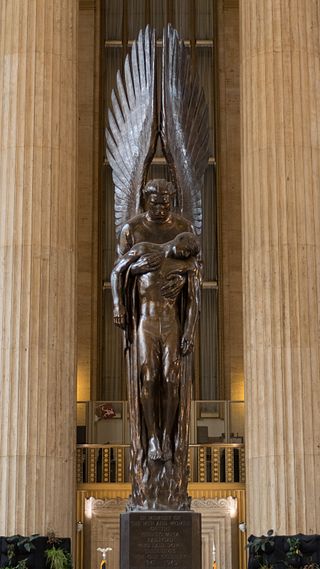
The Pennsylvania Railroad World War II Memorial is a monument on the main concourse of 30th Street Station in Philadelphia, Pennsylvania. It commemorates the 1,307 Pennsylvania Railroad employees who died in World War II.

The Dillon Memorial is a historic structure located in LeClaire Park, near downtown Davenport, Iowa, United States. It was listed on the National Register of Historic Places (NRHP) in 1983 and on the Davenport Register of Historic Properties in 1993. It is commonly referred to as the Dillon Fountain.

Washington, D.C., the capital of the United States, has a unique and diverse architectural history. Encompassing government, monumental, commercial, and residential buildings, D.C. is home to some of the country's most famous and popular structures designed by some of the leading architects of their time. The popularity of Washington's buildings is evident by the fact that a 2007 poll of Americans by the American Institute of Architects found that six of the top 10 most popular U.S. structures were located in Washington, D.C. Overall, 17 of the top 150 most popular structures were located in the capital.


















